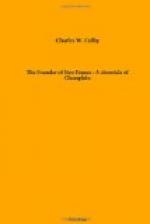We come now to the Voyage of 1615, which describes Champlain’s longest and most daring journey through the forest—an expedition that occupied the whole period from July 9, 1615, to the last days of June 1616. Thus for the first time he passed a winter with the Indians, enlarging greatly thereby his knowledge of their customs and character. The central incident of the expedition was an attack made by the Hurons and their allies upon the stronghold of the Onondagas in the heart of the Iroquois country. But while this war-party furnishes the chief adventure, there is no page of Champlain’s narrative which lacks its tale of the marvellous. As a story of life in the woods, the Voyage of 1615 stands first among all Champlain’s writings.
As in 1609, there was a mutuality of interest between Champlain and the Indians who traded at the Sault. His desire was to explore and theirs was to fight. By compromise they disclosed to him the recesses of their country and he aided them against the Iroquois. In 1615 the Hurons not only reminded him of his repeated promises to aid them, but stated flatly that without such aid they could no longer attend the annual market, as their enemies were making the route too unsafe. On their side they promised a war-party of more than two thousand men. A further proof of friendship was afforded by their willingness to receive a missionary in their midst—the Recollet, Father Joseph Le Caron.
Champlain’s line of exploration in 1615-16 took the following course. He first ascended the Ottawa to the mouth of the Mattawa. Thence journeying overland by ponds and portages he entered Lake Nipissing, which he skirted to the outlet. French River next took him to Georgian Bay, or, as he calls it for geographical definition, the Lake of the Attigouautan [Hurons]. His own name for this vast inland sea is the Mer Douce. That he did not explore it with any degree of thoroughness is evident from the terms of his narrative as well as from his statement that its length, east and west, is four hundred leagues. What he saw of Lake Huron was really the east shore of Georgian Bay, from the mouth of French River to the bottom of Matchedash Bay. Here he entered the country of the Hurons, which pleased him greatly in comparison with the tract before traversed. ’It was very fine, the largest part being cleared, and many hills and several rivers rendering the region agreeable. I went to see their Indian corn, which was at that time [early in August] far advanced for the season.’
Champlain’s route through the district between Carmaron and Cahaigue can best be followed in Father Jones’s map of Huronia. [Footnote: This map will be found in ’The Jesuit Missions ’in this Series, and also in vol. xxxiv of ‘The Jesuit Relations,’ ed. Thwaites.] The points which Champlain names are there indicated, in each case with as careful identification of the locality as we are ever likely to get. For those who are




